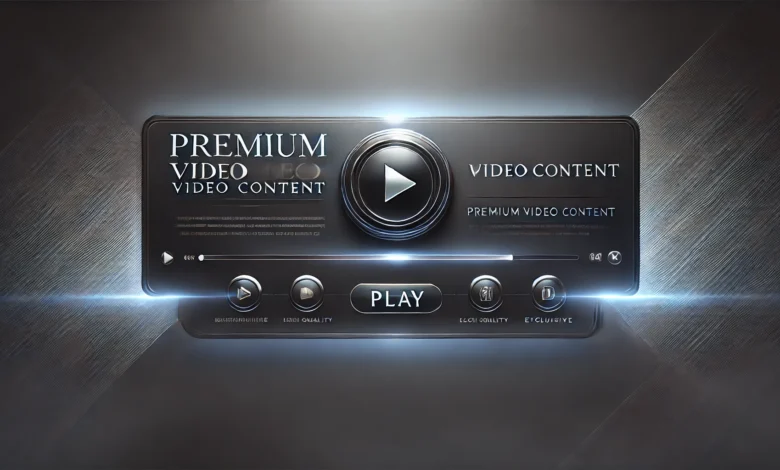Premium Video Content: Why It Matters and How to Create It Like a Pro

Introduction: Welcome to the Age of Premium Video Content
We live in a world where video is king. From TikToks to YouTube tutorials, people crave video content more than ever. But while short, snackable clips dominate social media, there’s another tier of video that’s quickly rising in value: premium video content. We’re talking high-quality, polished, professional-grade videos designed not just to entertain but to inform, sell, or inspire. This isn’t your average smartphone vlog. Premium video content is becoming a crucial asset for brands, influencers, educators, and marketers.
Why? Because quality content doesn’t just catch attention—it holds it. And in an online environment where attention spans are shorter than ever, retention is everything. Let’s dig into what makes video content “premium,” why it matters, and how you can produce it without breaking the bank.
What Exactly Is Premium Video Content?
Premium video content refers to video that is not only high in production quality but also valuable in terms of substance. It could be a corporate training video, a documentary, a product demo, a webinar, or even a cinematic YouTube series. What separates it from casual video content is its intentionality—every frame has a purpose.
Production quality is a big part of this. We’re talking professional-grade cameras, crisp audio, good lighting, and thoughtful editing. But it’s not all about the gear. A script that tells a story, a clear message, and a strategy for distribution are just as important.
Think of it this way: If video content were coffee, your phone-shot, vertical selfie videos might be instant coffee. Premium video content? That’s the hand-poured, single-origin espresso shot by a barista who knows your name.
Why Premium Video Content Is a Game-Changer for Brands and Creators
The benefits of premium video content are massive, especially when you compare the return on investment to other forms of media. First, it builds credibility. Let’s face it—if your video looks like it was edited in five minutes with stock transitions and pixelated graphics, people might question your authority or professionalism.
Second, premium videos convert. Whether you’re launching a product, onboarding new customers, or educating an audience, a well-crafted video can increase engagement and lead to direct action. Statistics show that people retain 95% of a message when they watch it in a video, compared to just 10% when reading it in text.
Finally, premium content is evergreen. A high-quality video can be repurposed across platforms, used in marketing campaigns, and embedded in websites for months or even years. That means more bang for your production buck.
The Essential Elements of Premium Video Content
So, what makes video content truly “premium”? Here are the core components:
1. Strong Narrative: Every great video tells a story. Whether it’s explaining a concept, showcasing a customer success story, or walking through a how-to guide, the narrative should guide the viewer from beginning to end.
2. Visual Aesthetics: This includes everything from camera angles and lighting to color grading and animations. Premium videos look clean, consistent, and visually pleasing. No shaky handheld shots unless they serve a stylistic purpose.
3. Crisp Audio: Audio is often overlooked but it’s arguably more important than video. Background noise, poor mic quality, or inconsistent sound levels can tank your viewer retention.
4. Professional Editing: Good editing is more than just cutting scenes together. It’s about pacing, transitions, music choice, text overlays, and more. A skilled editor can elevate mediocre footage into a compelling final product.
5. Clear Purpose and CTA: Every premium video should have a goal—whether it’s to inform, persuade, or inspire action. A strong call-to-action (CTA) at the end gives viewers the next step.
How to Start Creating Premium Video Content (Even If You’re on a Budget)
You might think creating premium video content requires a Hollywood-sized budget. Not true. With the right strategy and tools, even small businesses and solo creators can make high-quality videos. Here’s how:
Invest Smart in Equipment: You don’t need a $5,000 camera to get started. Many DSLRs and even newer smartphones shoot in 4K. What matters more is lighting (softbox kits are inexpensive) and audio (a good lapel or shotgun mic is a must).
Use Editing Software Wisely: Programs like Adobe Premiere Pro or Final Cut Pro offer powerful editing capabilities, but if you’re just starting out, tools like DaVinci Resolve (free) or CapCut can do the job well.
Plan Before You Shoot: Scripting your video saves time and ensures you stay on message. Storyboarding your shots also helps you visualize the final product and avoid wasting footage.
Leverage Freelancers: Can’t shoot or edit yourself? No problem. Platforms like Fiverr and Upwork are full of talented videographers and editors who can bring your vision to life.
Repurpose Content: Don’t create a one-and-done video. A 5-minute video can be split into shorter clips, turned into a blog post, or used as part of an email series.
Where to Distribute Premium Video Content for Maximum Impact
Creating the content is half the battle. The other half? Getting it seen. Depending on your audience, different platforms will offer different levels of engagement.
YouTube: Ideal for long-form videos, tutorials, and evergreen content. With SEO optimization, your content can gain views passively over time.
LinkedIn: Great for B2B-focused videos, especially thought leadership and corporate branding content. Videos under 2 minutes tend to perform best here.
Instagram & TikTok: Good for teaser clips or repurposed snippets. Vertical formats and captions are essential for mobile engagement.
Email Marketing: Embedding video in newsletters or as clickable thumbnails can increase open rates and engagement.
Your Website: Hosting videos on landing pages or blog posts can improve time-on-site and help guide visitors through the sales funnel.
The Future of Premium Video Content: AI, Interactivity, and Beyond
The landscape of premium video is evolving fast. AI tools are making it easier to automate editing, generate voiceovers, and even create scripts. Meanwhile, interactive video content is on the rise, offering clickable elements and personalized journeys that boost viewer engagement.
Brands are also exploring immersive formats like 360-degree video and augmented reality (AR). As production tools become more accessible, expect to see a surge in not just more content, but better content.
That means if you start building your premium video strategy now, you’re not just keeping up—you’re getting ahead.
Conclusion: Time to Level Up Your Video Game
Premium video content isn’t just a nice-to-have anymore—it’s a key differentiator in today’s digital space. Whether you’re a brand looking to stand out or a creator trying to grow your influence, investing in quality video is one of the smartest moves you can make.
You don’t need a massive budget or a production crew. You just need a clear plan, the right tools, and a bit of creativity. So grab your gear, start scripting, and start producing content that doesn’t just get watched—it gets remembered.



